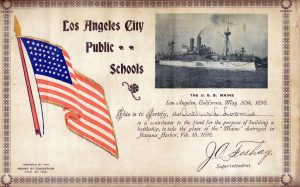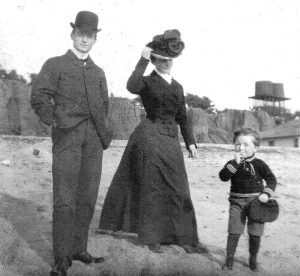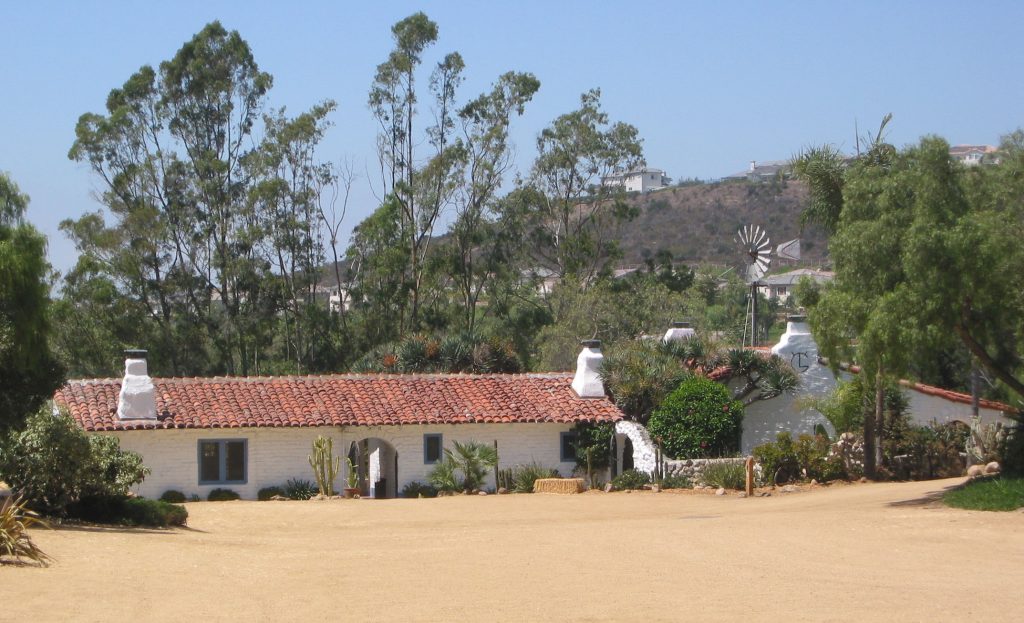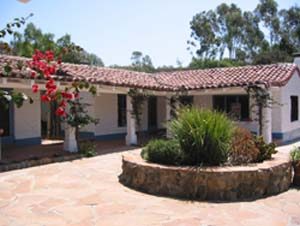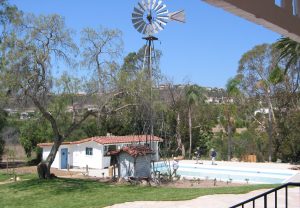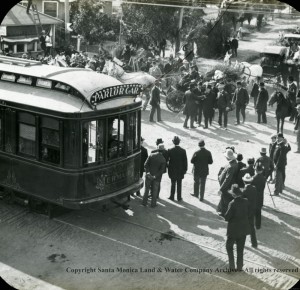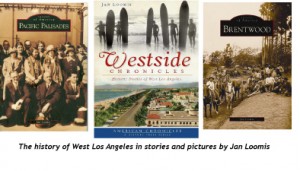Sculptor, Suffragette.
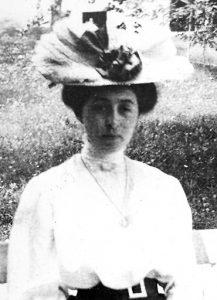
Artist Betty Edmund moved to Santa Monica from Maine with her parents as an eight-year-old. Her father, as so many did, migrated to California searching for a warmer climate with the hope that it would improve his health. His wife’s cousin Frances Gillis lived in Santa Monica so the family bought a property in Rustic Canyon and built the first private residence adjacent to the Forestry Station. The family pitched a tent under a large oak tree on the floor of the canyon living there for a year while their house was built.
George Edmund was a Johns Hopkins trained geologist and his first job in California was an exhaustive study of the paleontology of the Santa Monica Mountains. In 1907 under the auspices of MIT he undertook a study of the geology of the Baja Peninsula.
His home, reached by a dirt road and behind the locked gate of the Forestry Station, was often a playground and camping site for his daughter, her cousins Adelaide and Dorothy Gillis, and their friends. Betty Edmund grew up with a love of nature and a talent for sculpture. She also grew up with a mind of her own and a strength of character that made her, in addition to an acclaimed artist in a male-dominated field, a dedicated feminist.
California was a leader in the Suffrage movement granting the vote to women in 1911, a full ten years before women were granted the national vote. Betty and her cousin Adelaide Gillis were strong supporters of the women’s suffrage movement both in California and in the United Kingdom. Family stories mention that Betty marched with the suffragettes in London while she studied there.
Unusual for a woman, Betty studied art seriously in Boston, New York at the Art Student’s League, and for two years in Paris. She trained as a sculptor as well as a painter. She was quickly identified for her talent. Her sculptures began finding their ways into exhibitions in Paris, London, and New York as well as Los Angeles.
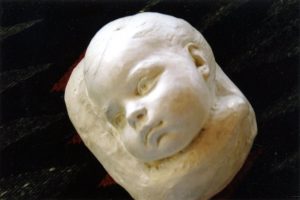
by Betty Edmund
As war broke out in Europe in 1913, she returned from Paris and set up a studio in Pasadena. Eventually, a friend from her Paris days, painter Helen Blum joined her in her repurposed barn studio. Both artists had exhibited in both Paris and London as well as Los Angeles. Betty’s work, “In Arcady,” a study of five young girls dancing in a garden was exhibited at the Paris Salon in 1913. It was purchased by an English art collector.
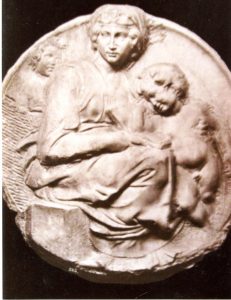
by Betty Edmund
In addition, she joined her fellow female artists in supporting the Suffragette Movement. An exhibition of female artists’ work was organized in a New York gallery during the Fall of 1915. Each artist donated a painting or sculpture to the show to be sold with the funds to be used to support the Suffragette Campaign. Betty Edmund was an enthusiastic member of this group and sent a sculpture from California to be sold. The artists also offered portraits to those who came to the exhibition at half price with the funds going to the Movement.
When the United States entered World War I, Betty volunteered to go to France and use her sculpture skills to create War Masks for soldiers with facial wounds or burns from the war. Plastic surgery was in its infancy and these masks, plaster or copper reproductions of the faces of soldiers who had facial deformities from wounds, were one of the only remedies available to help the men return to some semblance of normalcy.
Since Betty was a talented sculptor and was also fluent in French she was accepted for the program. When her friends queried her choice to go overseas and into a war zone, she told them that if she had been a man she would already be serving in the war and her feminity did not disbar her from service. She was required to have her tonsils removed before going overseas. Unfortunately, she died from this supposedly minor operation. She was 28 years old with a bright future ahead of her in her chosen field.
After her death, her fellow artists organized a memorial exhibit of 21 sculptures from her oeuvre to honor her memory. Held in Exposition Park, the exhibit included sculptures loaned by a number of collectors who had recognized her talent. The exhibition was well-attended and her work was much praised by the local art critics who mourned her short life and her loss as an exceptional sculptor.
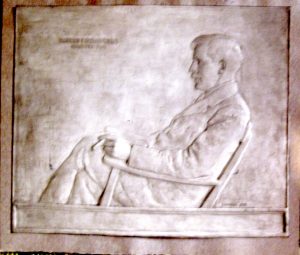
Exposition Park, Los Angeles
The Edmunds continued to live in Rustic Canyon until the 1920s when George’s widow sold the property to the members of the Uplifters for use as their clubhouse. Eventually, the house burned down and a new more purpose-built clubhouse replaced it. Over the years Uplifter members bought lots and built homes, many of them log cabins, near the original Edmund home changing the canyon from a wild natural setting into an upscale suburb of Los Angeles. The Uplifter clubhouse and grounds including the original Edmund property are now part of the Rustic Canyon Recreation Center.
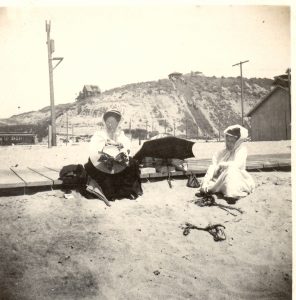

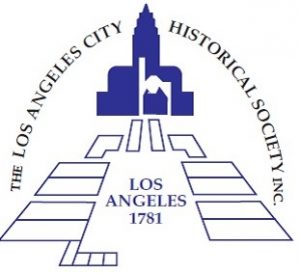
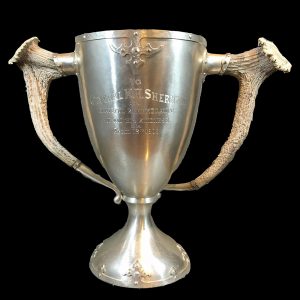 The silver cup presented to Gen. Sherman has distinctive antler handles and is inscribed on the front of the cup. “To General M.H. Sherman in Grateful Remembrance of all his kindness on April 18th 1906.” The back of the cup has the signatures of the California Supreme Court judges that went north on Sherman’s relief train. B. McFarland [Thomas B. McFarland], William H. Beatty, Frederick W. Henshaw, Frank M. Angellotti, Lucian Shaw, G. Lorigan [William G. Lorigan], and M.C. Sloss
The silver cup presented to Gen. Sherman has distinctive antler handles and is inscribed on the front of the cup. “To General M.H. Sherman in Grateful Remembrance of all his kindness on April 18th 1906.” The back of the cup has the signatures of the California Supreme Court judges that went north on Sherman’s relief train. B. McFarland [Thomas B. McFarland], William H. Beatty, Frederick W. Henshaw, Frank M. Angellotti, Lucian Shaw, G. Lorigan [William G. Lorigan], and M.C. Sloss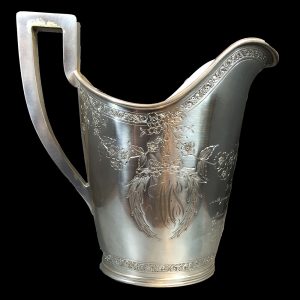
 Santa Monica was founded in 1875 with a well-advertised and well-attended land auction. The site on the mesa above the bay; the climate; and the promise of a new town ensured plenty of buyers and sales. Lots on Ocean Avenue went for $400-$500. Lots further back from the bluff went for as little as $75. By the end of the three day sale about a $100,000 ($2,631,578 in today’s money) worth of property had been sold and Santa Monica was on its way. Two months later almost 100 homes were going up; two hotels were full of guests; businesses were springing up to service the new town.
Santa Monica was founded in 1875 with a well-advertised and well-attended land auction. The site on the mesa above the bay; the climate; and the promise of a new town ensured plenty of buyers and sales. Lots on Ocean Avenue went for $400-$500. Lots further back from the bluff went for as little as $75. By the end of the three day sale about a $100,000 ($2,631,578 in today’s money) worth of property had been sold and Santa Monica was on its way. Two months later almost 100 homes were going up; two hotels were full of guests; businesses were springing up to service the new town.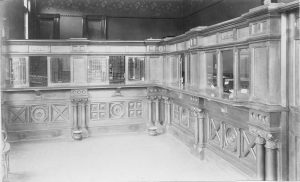 building Third Street, but immediately began planning for a new building of its own. In February 1889 the bank moved to its brand new two story building built especially for its needs. In 1893, the Vawter’s sold their interests in the bank to Senator John P. Jones and changed the name to the Bank of Santa Monica. Their stationary shows an engraving of their building and a list of the directors of the bank. The building is gone now, but it must have been an imposing addition to the young growing town. The interior sported carved wood, brass spittoons, and the Water office.
building Third Street, but immediately began planning for a new building of its own. In February 1889 the bank moved to its brand new two story building built especially for its needs. In 1893, the Vawter’s sold their interests in the bank to Senator John P. Jones and changed the name to the Bank of Santa Monica. Their stationary shows an engraving of their building and a list of the directors of the bank. The building is gone now, but it must have been an imposing addition to the young growing town. The interior sported carved wood, brass spittoons, and the Water office.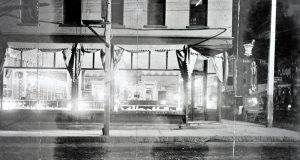 “The entrance is at the corner of two thoroughfares which the store faces. The main Third Street front consists of two immense plate-glass windows, while there is a still larger window next to the entrance on Utah Avenue. These windows and the glass doors expose the entire interior, which is as beautiful as any picture ever conjured from the busy brain of an artist…It is an establishment that is a noted ornament of the town and we are sure you will all join us in its praises.”
“The entrance is at the corner of two thoroughfares which the store faces. The main Third Street front consists of two immense plate-glass windows, while there is a still larger window next to the entrance on Utah Avenue. These windows and the glass doors expose the entire interior, which is as beautiful as any picture ever conjured from the busy brain of an artist…It is an establishment that is a noted ornament of the town and we are sure you will all join us in its praises.”